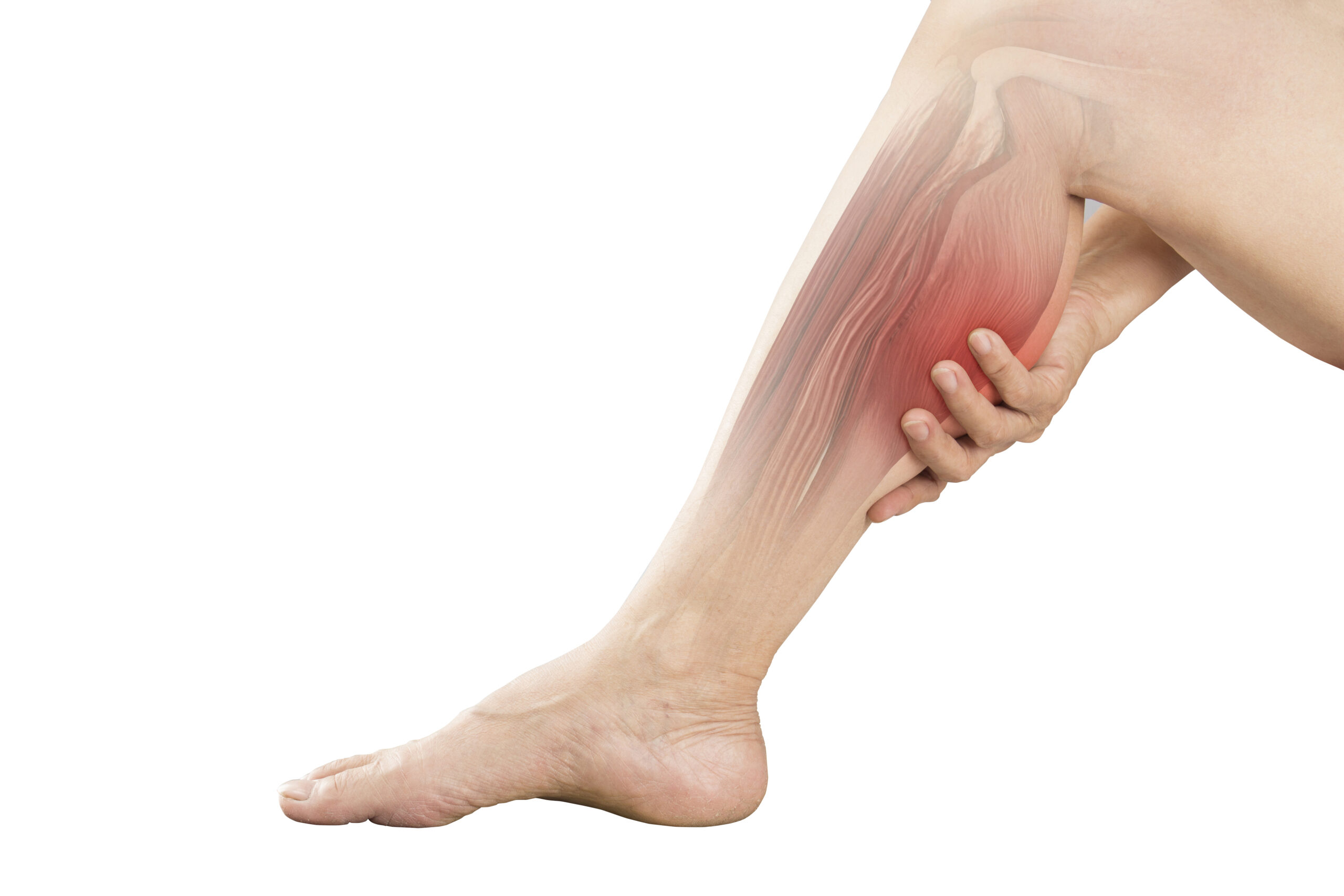Calf Cramps vs. Spasms: The Intertwined Relationship
There’s a difference between calf cramps and calf spasms when it comes to what sparks them, their duration, and your level of pain.
Calf cramps are more intense, prolonged contractions, and their duration can range from a few minutes to several hours. Muscle overuse or dehydration can cause calf cramps, and those enduring them can suffer from severe and debilitating pain.
However, an involuntary contraction of your calf muscles can cause a spasm. Inflammation of the nerves or muscle fatigue is often the cause of spasm symptoms. In fact, it’s possible for calf spasms to be painful, yet oftentimes mild and short-lived.
Whether it’s a cramp or spasm, studies have been published over the years on both conditions, and experts have specifically reported an association between nighttime leg cramps and sleep disruption. In general, 24 percent of patients have reported distressing pain when they go through constant leg cramps at night, with symptoms lasting nine minutes on average.
What’s Behind Calf Cramps in Muscles Versus a Spasm?
Anyone suffering from calf cramps knows that painful muscle spasms can also be connected to each nighttime cramping episode. Let’s start with a basic understanding of what’s actually happening in your body.
Your blood and circulatory system transport hydration and nutrients. They carry oxygen, vitamins, and water, as well as antibodies where they need to go. Blood moving into your muscles also accounts for the chemical interaction that allows your muscles to contract.
Blood flows faster through your veins when you exercise, because vessels widen and your heart rate increases. When you stop exercising, blood-flow slows down, vessels stop widening, and toxins begin to accumulate. You eventually end up with a painful muscle cramp from the build-up of toxins in your body in a scenario like this. Muscle cramps are more likely to occur when your workout intensity changes, with individuals in great physical condition usually only having leg cramps very briefly.
Muscle cramps can occur in many parts of the body, including the feet, hands, arms, and legs. Occasionally, chronic neck and back pain is caused by frequent muscle spasms in the neck, mid-back, and lower back. Constant leg cramps at night usually occur right in the middle of your seven-to-nine-hour sleep period, often waking you up.
There are many cases of nighttime leg cramps, also known as Restless Legs Syndrome (RLS). Most adults will experience nocturnal leg cramps at some point in their lives.
What Do Multiple Cramps in the Same Muscle Mean?
A strained or damaged muscle that’s near the cramped area may be the cause of your calf cramps. This is especially true if it occurs frequently in the same muscle. To repair damaged soft tissues such as muscles, tendons, and ligaments, the body grows scar tissue and adhesions. These bind torn tissue back together as quickly as possible.
Due to its non-elasticity, scar tissue will usually lead to a loss of range of motion. You may experience scar tissue for weeks, months, or even years, depending on how active you are. It’s important to see a physician or pain management specialist if you experience ongoing muscle spasms that cause daily stiffness and tightness. This — combined with scar tissue build-up and adhesions — can sometimes lead to even more pain, which is a very debilitating lifestyle. Eventually, scar tissue can stiffen your muscles, entrap nerves, and restrict movement, thereby reducing soft tissue elasticity and blood circulation.
While constant leg cramps at night are an issue for many, muscle spasms are usually associated, which are characterized by a tightening or stiffening of the muscle. For women, it’s good to know that menstruation and pregnancy are the most common causes (and most benign) of muscle spasms.
In addition to poor circulation in the legs, alcoholism and cardiovascular diseases can cause muscle spasms. Spinal issues like arthritic changes and spinal cord injuries can cause muscle spasms too. So can hormonal issues, underactive thyroids, low red blood cell count, and nerve dysfunction. Not to mention a myriad of other conditions like kidney failure and low mineral levels (Namely potassium or calcium). Numerous medications can also lead to muscle spasms, as well as prevalent diseases of the nervous system.
Anatomy of a Calf Muscle and Your Calf Cramps
Walking, running, and jumping are all activities that require healthy calf muscles so you don’t end up with calf cramps. Many athletics and sports hobbies also need healthy muscles, so it’s important for overall performance — whether daily at work, outside, at home, or having fun.
First, consider the back side of your lower leg. It’s a sturdy, powerful engine that propels you forward. There are two main muscles in the calf, as well as a few support muscles that work together. Calf muscles consist of two different types (gastrocnemius and soleus), which amount to two powerhouses combined to make up the Triceps Surae — your strongest muscle group in the lower leg.
This bulge at the back of your lower leg is commonly referred to as your chief calf muscle, with a single tendon connecting to your ankle. A broad, flat muscle lies beneath the gastrocnemius and plays a key role in downward flexible movement of your foot. Your Achilles Tendon originates from the shin bone and calf bone, joining to your gastrocnemius.
It gets even more complex — and amazing. Between your calf muscles and heel bone, the Achilles Tendon is the largest and strongest in your entire body. When walking, running, or jumping, it transmits the muscle’s force for a flexible range of motion. To support this structure, a thick layer of fascia surrounds your calf muscles, providing them with stability. Nerves and blood vessels travel through the fascia, carrying nutrients and controlling muscle movement.
Calves are remarkable muscles that power our everyday movements and athletic endeavors. Due to their intricate anatomy — consisting of powerful muscles, supportive tendons, and protective fascia — they are able to move efficiently and provide stability.
Here’s a helpful reminder. Next time you flex your foot or step forward, take note of this remarkable muscle group’s strength and coordination. Remember it when you suffer from constant leg cramps at night.
Your Calves are More Than Surface Deep
It’s important to remember that valves in your blood veins deteriorate as you age, resulting in less blood flow to your heart and potential “heaviness” or calf cramps in your legs. This problem is exacerbated for some individuals by consuming an unhealthy diet and living an unhealthy lifestyle. Improper blood circulation causes swelling — and that’s not good.
The most common cause of “venous insufficiency” is in older adults and those who don’t take their diet as seriously as they should. In most cases, this condition links itself to your heart and circulatory system. As such, shortness of breath, chest pain, and abnormal heart rhythms can accompany your leg swelling. Inflammation also finds other parts of your body. Your leg swelling just might be signaling a more serious problem.
Doctors often associate some of these symptoms with more serious circulatory conditions, such as Superficial Venous Insufficiency (SVI), Deep Venous Insufficiency (DVI), Deep Vein Thrombosis (DVT), Peripheral Artery Disease (PAD), varicose veins (twisted and enlarged veins), and edema (swelling caused by trapped fluids). In addition, infections, injuries, and arthritis can also cause swelling in your legs.
A little puffiness won’t cause any problems if it goes away within a day or two. However, if your constant leg cramps at night won’t stop, an experienced pain management specialist should be consulted if the pain persists — especially if only one leg is affected (rather than both) or if other bodily symptoms are present.
Wellness and Pain Can Help
A range of options for treating calf cramps are available at Wellness and Pain. We offer conservative treatments, routine visits, and minimally invasive quick-recovery procedures. We can keep you free of problems by providing lifestyle education and home care advice to help you avoid and manage issues, quickly relieving the inhibiting lifestyle conditions when complications arise.
At Wellness and Pain, we personalize patient care plans based on each patient’s condition and unique circumstances to relieve pain, improve mobility and mental space, and improve your overall health.











